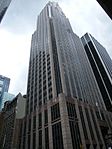Belasco Theatre

The Belasco Theatre is a Broadway theater at 111 West 44th Street, between Seventh Avenue and Sixth Avenue, in the Theater District of Midtown Manhattan in New York City. Originally known as the Stuyvesant Theatre, it was built in 1907 and designed by architect George Keister for impresario David Belasco. The Belasco Theatre has 1,016 seats across three levels and has been operated by The Shubert Organization since 1948. Both the facade and interior of the theater are New York City landmarks. The main facade on 44th Street is made of red brick in Flemish bond, with terracotta decorative elements. The ground floor contains the entrance, while the upper stories are asymmetrical and topped by a pediment. Belasco and his company had their offices in the western wing of the theater. A ten-room duplex penthouse apartment occupies the top of the eastern wing and contained Belasco's collection of memorabilia. The interior features Tiffany lighting and ceiling panels, rich woodwork, and expansive murals by American artist Everett Shinn. The auditorium consists of a ground-level orchestra and two overhanging balconies, with boxes at the second balcony level. The theater was developed by Meyer R. Bimberg and operated by David Belasco as the Stuyvesant Theatre. It opened on October 16, 1907, and was expanded in 1909 with Belasco's apartment. Belasco renamed the venue for himself in 1910. After his death in 1931, Katharine Cornell and then the wife of playwright Elmer Rice leased the space. The Shuberts bought the theater in 1948 and leased it to NBC for three years before returning it to legitimate use in 1953. Through the late 20th century, despite a decline in the quality of productions hosted at the Belasco, it continued to show Broadway plays and musicals. The theater was renovated multiple times over the years, including in the 1920s, 1970s, and 2000s.
Excerpt from the Wikipedia article Belasco Theatre (License: CC BY-SA 3.0, Authors, Images).Belasco Theatre
West 44th Street, New York Manhattan
Geographical coordinates (GPS) Address External links Nearby Places Show on map
Geographical coordinates (GPS)
| Latitude | Longitude |
|---|---|
| N 40.756666666667 ° | E -73.983888888889 ° |
Address
Belasco Theatre
West 44th Street 111
10036 New York, Manhattan
New York, United States
Open on Google Maps








